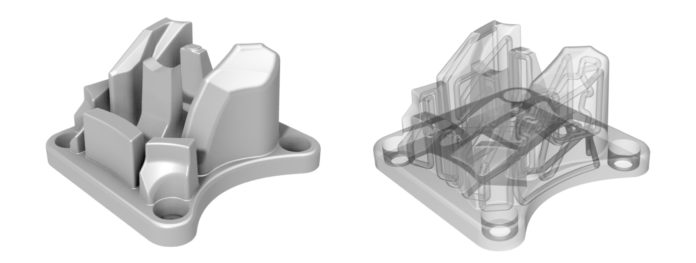A recent conversation with GE Additive’s CEO Jason Oliver pointed out that the tools & dies industry was a growing adopter of Additive Manufacturing as the sector can save millions of euros via AM applications. However, the use of AM in this sector comes with an array of technical challenges related to cooling channels in the applications.
Indeed, temperature fluctuations during the cool down phase increase the risk of work pieces getting warped. Not to mention that, since the cooling system follows the contours of the produced part, cool down times can reduce significantly.
A part that is produced with Selective Laser Melting technology might for instance, keep powder that negatively impacts the functionality of the part, resulting therefore in reduced flow rates due to high friction, turbulences, pressure loss in the system and loose particles that can damage other equipment.
A finishing process is therefore crucial to deliver the desired functional part but how do we choose between the product mix found on the market?
AM Solutions, the AM brand of Rösler, has conducted a study with the mechanical and chemical engineering departments of the Politecnico Milano (Italy) to discover the impact of surface treatment methods on the manufactured parts. Launched last year, AM Solutions combines all Rösler’s activities regarding additive manufacturing.
Methods such as mass finishing, shot blasting and chemically supported mass finishing have been reviewed.
A critical choice for operators
To achieve the study, parts with different shapes and internal passages with different diameters (3, 5, 7.5 and 10 mm) have been tested.
Surprisingly, results revealed that all three surface treatment systems deliver similar results but chemically supported mass finishing seems to deliver the best results.
Indeed, with mass finishing, operators can smooth the external and internal surface areas of AM components whereas conventional mass finishing and shot blasting consistently enable to remove the roughness peaks to produce similar surface roughness profiles.
Speaking of mass finishing, the company explains that “during the finishing process the work pieces are immersed into a circular work bowl filled with special processing media. In addition, dedicated compounds are added during the process. The vibration of the work bowl causes the media and work pieces to move around the bowl in a spiral movement. The constant “rubbing” of the media against the work pieces produces a grinding/smoothing effect resulting in the desired surface quality.”.
According to experts, this treatment method is uniquely positioned to deliver smoothing effect on the internal surface channel areas without affecting the channel geometry.
However, with Ra values of 0.7 µm the chemically supported mass finishing technique achieves the lowest surface roughness values in the shortest cycle time. The study revealed that the final roughness values remain the same than in vertical and horizontal internal passages.
What’s next?

AM Solutions is further developing its M3 System. Designed for the treatment of internal passages, the company will further focus on automation of consistent finishing of 3D printed components.
This is no surprise as automation will not only speed up this stage of manufacturing, but by removing manual work, it will also further protect operators from risks associated to powder handling.
For now, the loading and unloading of the work pieces can already be automated with a robot and this is already a great advantage for operators who used to struggle to process internal channels of AM components.
Photo : Rösler Oberflächentechnik GmbH – Remember, you can post free of charge job opportunities in the AM Industry on 3D ADEPT Media or look for a job via our job board. Make sure to follow us on our social networks and subscribe to our weekly newsletter : Facebook, Twitter, LinkedIn & Instagram ! If you want to be featured in the next issue of our digital magazine or if you hear a story that needs to be heard, make sure to send it to contact@3dadept.com






